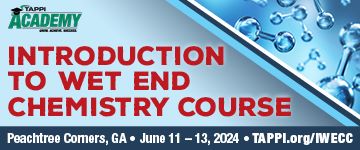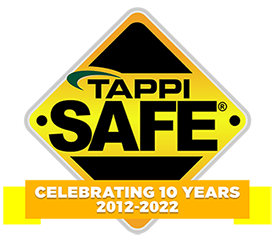 Search
Search
Use the search bar or filters below to find any TAPPI product or publication.
Filters
Content Type
Publications
Level of Knowledge
Committees
Collections
Journal articles

Ethylene-carbon monoxide extrudable adhesive copolymers for polyvinylidene chloride, June 1988, TAPPI Journal 88JUN140
Ethylene-carbon monoxide extrudable adhesive copolymers for polyvinylidene chloride, TAPPI JOURNAL June 1988
Journal articles

Fiber flocculation in pulp suspension flow-Part 2: Experimental results, TAPPI JOURNAL June 1988
Fiber flocculation in pulp suspension flow-Part 2: Experimental results, TAPPI JOURNAL June 1988
Journal articles

Techniques for expanding the sphere of statistical process control, TAPPI JOURNAL July 1988
Techniques for expanding the sphere of statistical process control, TAPPI JOURNAL July 1988
Journal articles

Birch thermomechanical pulp for newsprint via the Opco treatment, TAPPI JOURNAL July 1988
Birch thermomechanical pulp for newsprint via the Opco treatment, TAPPI JOURNAL July 1988
Journal articles

A fast-track approach through the design and permit phases for an ash landfill, TAPPI JOURNAL August 1988
A fast-track approach through the design and permit phases for an ash landfill, TAPPI JOURNAL August 1988
Journal articles

Fibers properties and tearing resistance, TAPPI JOURNAL February 1988 88FEB103
Fibers properties and tearing resistance, TAPPI JOURNAL February 1988
Journal articles

Magazine articles

Control of malodorous gases emission from wet-end white water with hydrogen peroxide, TAPPI Journal October 2021
ABSTRACT: White water is highly recycled in the papermaking process so that its quality is easily deteriorated, thus producing lots of malodorous gases that are extremely harmful to human health and the environment. In this paper, the effect of hydrogen peroxide (H2O2) on the control of malodorous gases released from white water was investigated. The results showed that the released amount of total volatile organic compounds (TVOC) decreased gradually with the increase of H2O2 dosage. Specifically, the TVOC emission reached the minimum as the H2O2 dosage was 1.5 mmol/L, and meanwhile, the hydrogen sulfide (H2S) and ammonia (NH3) were almost completely removed. It was also found that pH had little effect on the release of TVOC as H2O2 was added, but it evidently affect-ed the release of H2S and NH3. When the pH value of the white water was changed to 4.0 or 9.0, the emission of TVOC decreased slightly, while both H2S and NH3 were completely removed in both cases. The ferrous ions (Fe2+) and the copper ions (Cu2+) were found to promote the generation of hydroxyl radicals (HOœ) out of H2O2, enhancing its inhibition on the release of malodorous gases from white water. The Fe2+/H2O2 system and Cu2+/H2O2 system exhibited similar efficiency in inhibiting the TVOC releasing, whereas the Cu2+/H2O2 system showed better perfor-mance in removing H2S and NH3.
Journal articles

Magazine articles

Evaluation of rice straw for purification of lovastatin, TAPPI Journal November 2021
ABSTRACT: Cholesterol synthesis in the human body can be catalyzed by the coenzyme HMG-CoA reductase, and lovastatin, a key enzyme inhibitor, can reduce hypercholesterolemia. Lovastatin can be obtained as a secondary metabolite of Aspergillus terreus ATCC 20542. In this study, rice straw of lignocellulose was used in aeration and agitation bath fermentation in a 1-L flask, and a maximal crude extraction rate of 473 mg/L lovastatin was obtained. The crude extract was treated with silica gel (230•400 mesh) column chromatography. Ethyl acetate/ethanol (95%) was used as the mobile phase, and isolation was performed through elution with various ethyl acetate/ethanol ratios. The highest production rate of 153 mg/L was achieved with ethyl acetate/ethanol in a ratio of 8:2. The lovastatin gained from the crude extract was added to 12 fractions treated with 0.001 N alkali, and acetone was then added. After 24 h of recrystallization at 4°C, the extract underwent high-performance liquid chromatography. The purity had increased from 25% to 84.6%, and the recovery rate was 65.2%.
Journal articles

Oxygen bleaching of kraft pulp: high consistency vs. medium consistency, TAPPI JOURNAL February 1988 88FEB47
Oxygen bleaching of kraft pulp: high consistency vs. medium consistency, TAPPI JOURNAL February 1988
Journal articles

Effect of enzymatic pretreatment on the diffusion of sodium hydroxide in wood, TAPPI JOURNAL, January 1998, Vol. 81(1)
Effect of enzymatic pretreatment on the diffusion of sodium hydroxide in wood, TAPPI JOURNAL, January 1998, Vol. 81(1)






